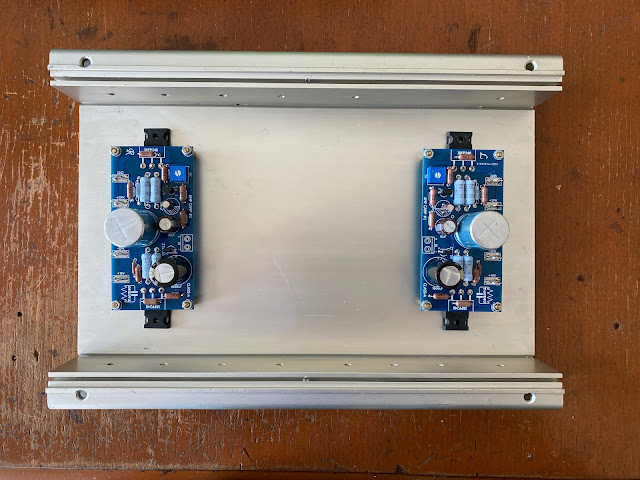The ACA amplifier was initially designed for beginner in DIY audio so they can start to build a discrete class A amplifier. And because of this reason, so the components and the design should be as simple as possible. This simple approach always shared the same philosophy as the designer itself, the Nelson Pass who own the Pass Labs and the First Watt.
The ACA amplifier is using only 2 transistor in the signal path. The JFET for voltage amplifier and MOSFET for current amplifier. Interestingly this amplifier can be powered with a pair of SMPS laptop power supply.
I heard from others that have tested it, this amplifier sound great.
So, since I already have the ACA PCB on hands, why don't I start building this amplifier?
I am also a beginner:)
In this ACA amplifier build, I really want to know how far "for the beginner" amplifier sounds like.
If you following my blog for years, you probably know that I have built the F5 amplifier before. This amplifier also designed by Nelson Pass but in the push-pull design. It sound incredible but at that time I have to sold it for funding my next project. The buyer really happy with that amplifier.
So I think this ACA amplifier is my second built for the Nelson Pass/First Watt amplifier family.
In this build, I using the pre-made PCB not in the point-to-point wiring as my usually did.
The PCB use here are double layer and high quality finished that I think I better use it anyway.
The components to build this amplifier are commonly available. Especially for the IRFP240 is the most common MOSFET transistor on the market. The others components such as ZTX450 also can be find easily, or substitute with different type of NPN transistor.
Especially for the JFET 2SK170BL is quite expensive but somehow still affordable.
It doesn't takes so much time to populate all components into this ACA amplifier PCB.
I use many components that are already on my hand such as Dale resistors, Panasonic and Elna Silmic capacitors.
In the ACA amplifier manual said that using the laptop SMPS rated 19 volt 3 ampere minimum for each channel are fine. This is so much opposite to the audiophile dogma that only using linear transformer power supply for having a good sounding amplifier.
So let's see how it goes with the SMPS power supply for this ACA amplifier.
Luckily I have the same specification SMPS and not harm to use it right now.
My ACA amplifier build is very economical. As you may aware that the high cost for building a class-A amplifier is mostly on the power supply and heat-sink. Instead, I using the heat-sink taken from the old car audio power amplifier case for this build.
Once I finished building this amplifier, then in the ACA manual, the only adjustment need to be addressed is dialing the trim-pot until the drain of the power transistor per channel is reach at 10 volt to ground. Once it is done, then this amplifier is ready to sing.
The procedure for best performance amplifier, specifically for the Class-A amplifier is require a warm-up time so the components reach their operating temperature first before start playing the music. During this warm-up process I check if there is any hum or any noise coming from my speaker connected to this amplifier and surprisingly this amplifier is dead quiet.
Then I start playing some music.
Wow, I never thought that this ACA amplifier can sound this good.
The sound is wide and open. The musicality is the strong point of this amplifier. The treble is presenting quite open and detail without harshness. The mid-range presenting with body, revealing the all the music details with wide sound-stage presentation. The bass deliver with enough punch and solid. Overall, this amplifier is very enjoyable to listen the music.
But this ACA amplifier is only deliver maximum 10 watt power output per channel. It should be okay with the high sensitivity speakers, but in my audio system with the 2 way speakers system that having only 86 dB sensitivity, this ACA amplifier is not a perfect match. It could be a perfect amplifier if it have more than 20 watt and can handle the music at higher volume level. Especially for more complex music presentation with lots of drums, kicks and dynamic, this ACA amplifier is start to fall.
In summary, I think this ACA amplifier is a great amplifier. The heatsink is hot after it idle around half hour. But this warm up process are required. The sound from a minute after it start compare to an hour after the temperature are about 48 degree, the sound quality are so much different.
The ACA amplifier is simple in design and the components to build this amplifier is not expensive. This probably will not drain your pocket out to having a nice class A amplifier.
But again, it is not a perfect amplifier at all.
This amplifier might be the perfect amplifier if the power output can be much higher. But it is depends on the music you listen or the speakers that you are pairing with this amplifier.
Disclaimer: Any statement and photos in this article are not allowed to copy or publish without written permission from the writer. Any injury or loss from following tips in this article is not under writer responsibility.









No comments:
Post a Comment